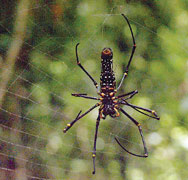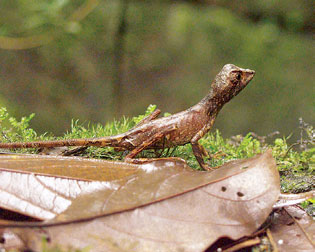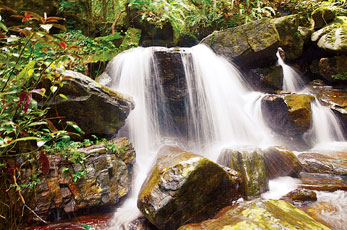Batadombalena forest, a soothing balm for mind and body
By Mahil Wijesinghe
|

The cave on top of the mountain with remains of the Buddhist
hermitage |
The mountains beckoned. Anyone who has witnessed the resplendence of
the verdant lush green Sinharaja forest would know the feeling. Just the
thought of laying eyes on that brilliant shade of green, found outside
the confines of concrete jungles; the feel of raindrops on your skin,
strangely rejuvenating your being; and the sight of innumerable small
waterfalls and streams snaking their way through the rocky outcrops and
flowing down the wilderness is enough to soothe one’s nerves.
Batadombalena forest reserve, which is renowned as a picnic spot,
besides being of historical significance, is nestled on a summit in a
thick forest in a sleepy hamlet known as Waladura, six kilometres from
Kuruwita in Ratnapura.
The Archaeological Department’s signboard in the centre of the town
shows visitors the way to the ancient cave and forest reserve. The road
is motorable up to four kilometres and the rest is a jungle path leading
to the cave, more than one kilometre away. The trek to the summit is
both long and adventurous. It is a steep footpath that runs through a
leech-infested jungle, with a canopy of trees providing cool shade.
Armed with my Nikon D7000, I set out to the Batadombalena forest
reserve with my two sons (both of whom had been hankering to visit the
cave on the summit of the mountain). The shop owner in the village
advised us to apply soap on our lower legs to keep the leeches away as
it is widely regarded by the local residents as the best repellent for
leeches.
The Batadombalena mountain range is an intrinsic part of prehistoric
Sri Lanka. The cave in this mountain was used as a Buddhist hermitage in
the recent past and the most significant feature is that archaeological
excavations have revealed that the area had seen human habitation 30,000
years ago. Among the discoveries were skeletons and various implements
believed to have been used by the Balangoda Man (Manawaya).
 |
|

Some of the wildlife in the forest, a spider and a lizard |
Hence, the Batadombalena cave holds a unique position in prehistoric
habitation in Sri Lanka. It played an important role in guarding the
surrounding forest areas, including the Batadombalena prehistoric cave.
The numerous small waterfalls and streams are major attractions during
the rainy season.
We started our trek from the village of Waladura, at the foot of the
hill. The charming hamlet is home to about five hundred inhabitants who
tend to their small tea lands. A few villagers operating roadside
boutiques sell beverages and food items to visitors of the Batadombalena
forest reserve.
Waterfalls and streams
The path leading to the summit winds through a small thicket, to a
robust full-grown jungle, to rock patches without any support railings
and finally in to the historic Batadombalena cave.
We could hear a strange buzz. It was not an insect. It wasn’t even
that irritating high altitude feeling. It was a calm that we had never
experienced before. It had rained heavily a few hours before our
arrival. The constant rumble of the numerous small waterfalls and
streams that dot the area, not to mention the sight of one roaring down
from dizzying heights, felt like balm for our minds and bodies.
It is only during the rainy season that these wonders come alive,
forming little streams that wind through the trees and creepers found
all over the jungle.
After trekking for about an hour, we reached the plateau from which
two mountains rise. Actually, it was a valley. The rest of the journey
was simple although a long trek. Climbing this portion of the rocky
face, especially during rainy days, can be risky, since the rock becomes
slippery and hard to get a grip on.
After braving this patch and a couple of non-fatal slips (thanks to
our impatience), we finally reached the plateau, and were more than well
rewarded for our efforts.
|

The lush vegetation of the Batadombalena forest reserve |
The view of the valley from this point was simply breathtaking. We
couldn’t even see the Waladura village in the middle of a vast green
ocean. The cool cascading streams started from the top of the cave,
swollen to their limit, shimmered their way across the plain, the summit
of the Batadombalena mountain stood in the distance.
The one-and-a-half kilometre walk to the Batadombalena cave was quite
enjoyable. The entire route was filled with forest canopy and was
infested with leeches and mosquitoes. At some places, we glimpsed
endangered insects such as butterflies, reptiles and fishes in streams.
After a one-and-a-half-hour climb, we reached the Batadombalena cave,
which rose majestically through the greenery. I imagined life at the
Batadombalena cave 30,000 years ago as I sat on a base of an excavation
mine dug by the Department of Archaeology to unearth the skeletons of
early inhabitants in this cave in the latter part of 1980.
This is the second oldest cave in Sri Lanka where the remains of
prehistoric humans have been found. The other caves where prehistoric
habitations have been found are the Fa-Hien cave in Bulathsinhala and
Beli Lena cave in Kithulgala, as well as the newest discovery - Kuragala
in Balangoda. Archaeologists are now excavating the Kuragala cave and
revealing the history of the prehistoric habitation of the Balangoda
Manawaya.
Ancient stone tools
Archaeologists also uncovered evidence of ancient stone tools which
have been used by ancient inhabitants in the Batadombalena cave. When
there were no houses in the forest, this cave must have sheltered the
ancient people from rain and sun. They may have lived amicably, feeding
themselves and their young on the fruits and meat hunted and gathered in
the forest.
|

One of the small waterfalls |
Even 500 people could, at a time, find shelter in this massive
Batadombalena cave, which comprises a cluster of small caves. It is a
rock that stands testimony to one of the world’s oldest human
civilisations.
A high waterfall cascaded from the peak of the rock like a long white
bridal veil. We walked around the cave, which had been a Buddhist
hermitage at one time, but is now deserted. We saw places where visitors
had scribbled names and addresses on walls, but the virgin forest
reserve is still not polluted by visitors, and is in immaculate
condition.
Everyone who hopes to visit this forest reserve must protect its
beauty for future generations. An unpleasant sight in this pleasant
environs is rapid deforestation in and around the forest reserve.
The villagers living along the slope of the mountain have cleaned the
jungle to make way for tea and rubber plantations. The plantations are a
great threat to the fauna and flora of the Batadombalena forest reserve.
It is imperative that the forest rangers take urgent action to halt the
deforestation that would result in the desecration of an ancient
historical treasure.
Here it is easy to forget who you are and where you are from.
Your menial everyday problems - differences with your boss, rebellion
against family and bickering among colleagues, all but melt away into
oblivion, in the wake of the divine beauty that unfolds in front of you,
leaving a sense of oneness with nature. |


